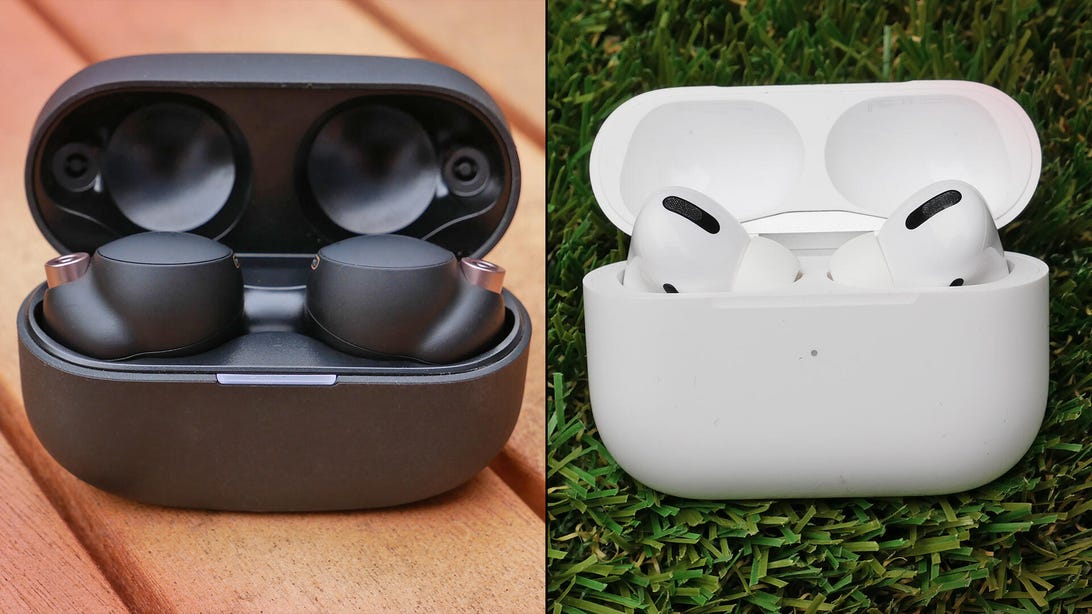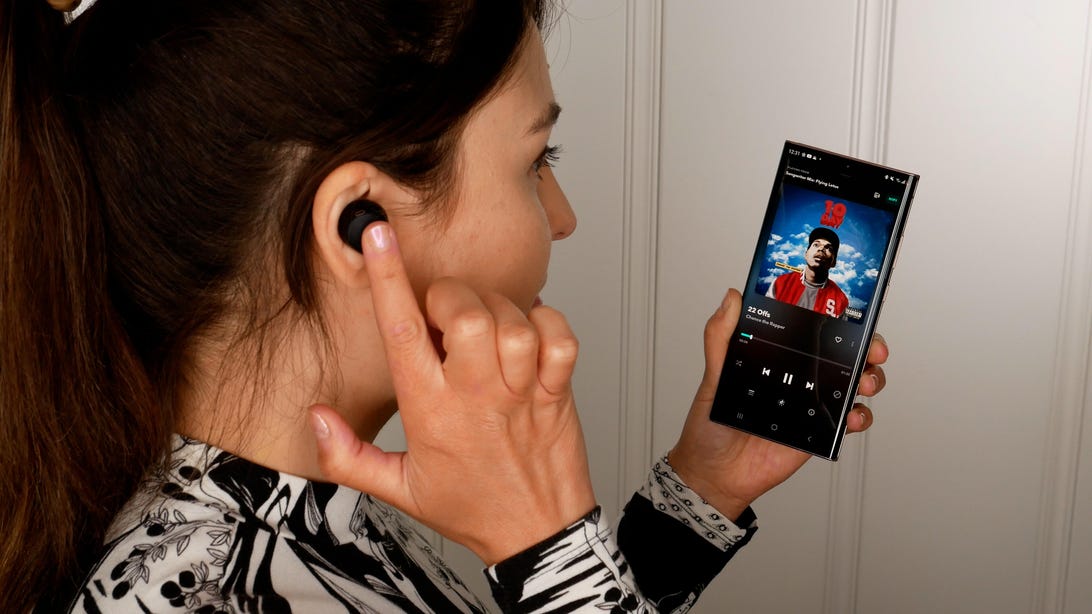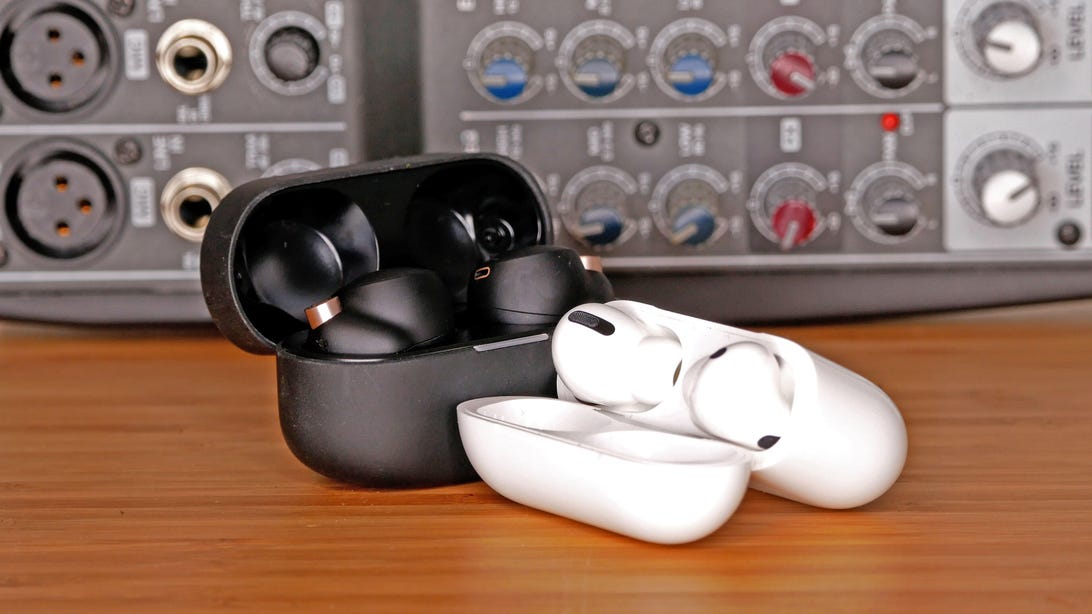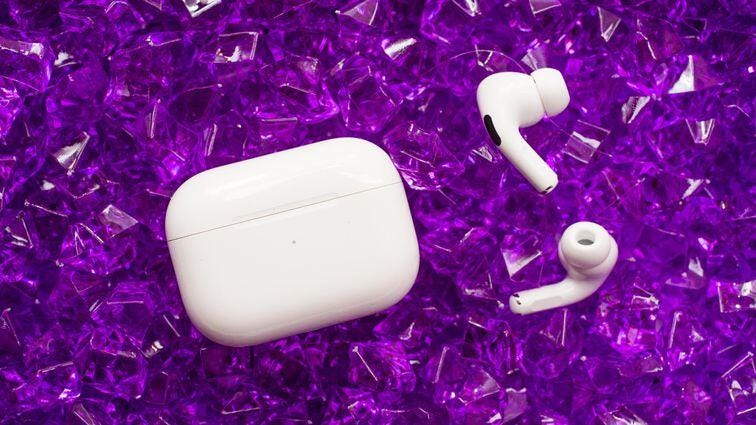There’s no shortage of excellent true wireless earbuds you can buy, but Apple’s AirPods Pro and Sony’s WF-1000XM4 are among the cream of the crop. Sony’s earbuds are only a bit more expensive at $280 (£250, AU$450) compared to $250 (£249, AU$249) for the AirPods Pro, so the decision really comes down to what phone you have and your primary use case. Are you looking for earbuds primarily to listen to music, or are you looking for a do-it-all pair?
I’ve been using both sets for over a month to help you determine which is right for you. I compared them across different categories like sound and call quality, how comfortable they are to wear for extended periods of time and overall battery life.
Lexy Savvides/CNET
Sony’s earbuds offer excellent sound quality and some of the strongest noise cancellation you can find in a pair of true wireless earbuds. You can also stream high-resolution Bluetooth audio on Android. The controls are fully customizable and the battery lasts longer than the AirPods Pro. But they are substantially heavier than Apple’s earbuds and smaller ears may have to experiment to find ear tips to provide a secure fit.
The AirPods Pro do everything really well: calls, music playback, noise cancellation and transparency mode. They don’t have as much bass as the Sony WF-1000XM4, or a battery that lasts as long, but they are a strong choice for iOS users who want quick switching and spatial audio for music and movies. They may also be more comfortable for some ears than the Sony buds, and you can regularly find them under $200.
AirPods Pro are more comfortable, especially for smaller ears
These earbuds couldn’t be more different in their design. The Sony WF-1000XM4 are round, while the AirPods Pro have a short stem that sticks down from your ear. Apple’s earbuds are significantly lighter and fit better in my small ears than the Sony earbuds, especially for prolonged wear. Larger ears shouldn’t have an issue with the Sony buds, but as always, fit varies from person to person.
Both pairs have three ear tip sizes to help get a snug fit. Sony’s tips are a hybrid foam mix, while Apple’s are silicone. While most people should be fine with the included tips, I actually found I had to change to different tips on both. I use third-party foam tips from Comply on the AirPods Pro and Sony’s silicone tips from the older WF-1000XM3. The tips provided with the Sony buds aren’t small enough for me and I really wish there was an XS size in the box.
I highly recommend using the ear fit test on both these buds to help you get the best seal and optimal sound quality. You can find this in the iOS settings for the AirPods Pro or within the Headphones Connect app on the Sony WF-1000XM4 (iOS and Android).
The WF-1000XM4 have touch panels that can change tracks, activate noise cancellation or even accept a call, while the AirPods Pro have clickable stems that do the same tasks. Sony’s earbuds are the only ones that let you adjust the volume from the touch panels. Both support a voice assistant for hands-free control: Siri for the AirPods Pro on iOS; Google Assistant and Alexa for the WF-1000XM4 on Android; Google Assistant, Alexa or Siri for the WF-1000XM4 on iOS.
You’ll also be able to wear both earbuds in the rain or during a sweaty workout as they are rated IPX4, which means they can withstand splashes of water. The charging cases, however, are not water resistant.

Lexy Savvides/CNET
Sony WF-1000XM4 sound dynamic and bright
Listening to music on the Sony buds is a real pleasure. The definition across frequencies is excellent, with vocals sounding clear and crisp. Bass is prominent without being overwhelming. It gave me the chills listening to some of my favorite tracks in a range of genres, from rock to hip-hop to classical music. The AirPods Pro also sound great, but they aren’t as dynamic on default settings and don’t have as big of a bass response as the Sony buds. I did prefer taking calls and podcasts on the AirPods Pro because the sound profile is more neutral and balanced for solo voices overall.
The AirPods Pro have an adaptive equalizer, so it’s constantly changing the sound profile automatically. You can tweak the sound further by using an equalizer in your favorite music app, or use the Headphones Accommodations feature in the iOS settings. Sony’s earbuds have an EQ in the app, although I found I didn’t need to use it very much as the default sound profile worked really well across a range of music genres.

Lexy Savvides/CNET
Sony’s earbuds also support LDAC, a high-resolution audio codec for Bluetooth headphones on Android phones. I listened to several songs on Tidal’s HiFi and Master stream quality, noticing slightly more definition than the same track with AAC streaming. Unless you’re an audiophile, I don’t think you’ll be able to tell that much of a difference, especially because Sony’s DSEE Extreme upscaling is really good and makes lower bitrate streams sound great.
You can hear microphone samples in the video on this page for both pairs, recorded on iOS and Android. Overall, I found the AirPods Pro worked better for calls than the Sony WF-1000XM4, both for phone calls and on Zoom or Google Hangouts.
Spatial audio on AirPods Pro is more robust than 360 Audio
That’s because it’s available for music and movies in a wide range of apps from HBO Max to Apple Music, Disney Plus and Apple TV Plus just to name a few. It’s also plug-and-play, so you just put the AirPods Pro in your ear, turn on spatial audio in the iOS settings, then watch or listen to your content. Sony’s 360 Audio only works for music playback in a smaller number of apps like Tidal and Nugz.net. It also takes a bit longer to set up, involving snapping photos of your ears.
Sony wins the noise-canceling crown, but AirPods Pro win transparency mode
Both earbuds have active noise cancellation to block out sounds from the outside world and do an excellent job of drowning out constant sound across a range of frequencies. To my ears, the Sony takes the edge for low frequencies like traffic, commuting or rumbling engines to create more of a cocoon of silence than the AirPods Pro.
Each pair also has an ambient sound mode, or what Apple calls transparency mode, to let in sound so you’re aware of your surroundings. The WF-1000XM4’s ambient sound mode has 20 adjustment levels to fine-tune the effect. You can also choose to focus on voices over other sounds, which works really well. It doesn’t sound as natural as transparency mode on the AirPods Pro, which to my ears is best in class and almost feels like you’re not wearing earbuds at all.

Lexy Savvides/CNET
The WF-1000XM4 battery will last you all day long
I couldn’t quite believe the Sony buds would get me close to the 8 hour rating on the box. But in my testing listening to music at a moderate volume with ANC, I was able to wear them for 8 hours and 10 minutes before they ran out of juice. There is a catch, though: if you stream using LDAC, your battery life will drop to around 5 hours. The AirPods Pro last up to 5 hours with ANC or transparency mode in my tests under the same conditions.
Each case also holds additional charge, up to 24h total for both pairs. The cases also support wireless charging, or you can juice them up with USB-C for Sony and Lightning for Apple. Something that other reviews might not mention is that the Sony charging case (at least the black version I’ve been using) shows every bump, drop and scratch that I’ve thrown at it over the past month.
The AirPods Pro is the only pair that offers quick switching, so you can seamlessly move between different Apple devices signed into the same Apple ID. The Sony WF-1000XM4 do not offer any multi-point capability, so if you want to move between your phone and laptop during the work day for example, you’ll have to go into the Bluetooth settings and switch over manually each time.
Sony WF-1000XM4 or AirPods Pro?
Both of these earbuds offer an excellent balance of performance and audio quality. There is no one-size-fits-all pair given they have strengths in different areas. Buy the AirPods Pro for the best experience across iOS and Apple devices thanks to quick switching, spatial audio and great call quality. Get the Sony WF-1000XM4 for high-res LDAC Bluetooth streaming on Android, long battery life and noise canceling that rivals over-ear headphones.






